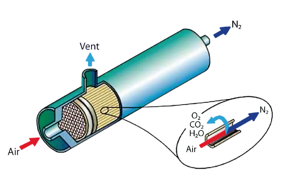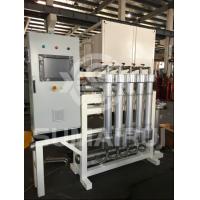Fiber laser cutting membrane nitrogen generator with 200 psi for
20000W working fully automatic by CE certificates
How Nitrogen Generators Work
MEMBRANE SEPARATION NITROGEN GENERATOR
The heart of a nitrogen generator using the Membrane Separation
technique is, unsurprisingly, the separation membrane. The membrane
consists of thousands of hollow fibers that compressed air is
passed through. The walls of each fiber are permeable to gas
molecules, but some gases can pass through more easily than others.
These ‘fast’ gases, including Oxygen, CO2, and water vapor, pass
through the fiber walls and are exhausted to atmosphere. The ‘slow’
gas, nitrogen, passes through the fiber wall much more slowly,
producing a high purity nitrogen stream at the membrane outlet.
There are no moving parts to the membrane, simply controlling the
pressure and flow rate of compressed air through the membrane
results in high purity nitrogen production.

PRESSURE SWING ADSORPTION (PSA) NITROGEN GENERATOR
PSA nitrogen generators utilize Carbon Molecular Sieve (CMS)
material to strip oxygen from the source compressed air. CMS
material consists of porous carbon with finely controlled pore
size. As compressed air passes over the material, oxygen molecules
are adsorbed into the pores, while the larger nitrogen molecules
can pass through to the exhaust gas. Eventually, the CMS will
become saturated with oxygen molecules and gas separation will no
longer occur.
For this reason, PSA generators are always designed with two or
more adsorption columns. One column is actively separating gas,
while the other one is being regenerated by passing high purity
nitrogen through it to strip out the oxygen and exhaust it as waste
gas. The generator switches between the two columns approximately
every 60 seconds. The need for switching between the two adsorption
columns results in the need for multiple automated control valves,
greatly increasing the potential points of failure in the unit.
Additionally, a nitrogen buffer tank is typically required to
ensure a constant pressure and flow rate during the switching
between the two adsorption columns.
Commonly Asked Question About How Nitrogen Generators Work
DO I NEED AN AIR DRYER OR ANY OTHER SPECIAL FILTRATION ON MY AIR
SUPPLY?
Membrane Separation: Each generator includes in-line filtration to
remove particulate, liquid water, and carry over hydrocarbons from
the air stream prior to entering the separation membrane. The Air
Products PRISM® membranes ECS uses are designed to filter out water
vapor, eliminating the need for a refrigerated or desiccant dryer
upstream of the unit.
Pressure Swing Adsorption (PSA): PSA units also typically include
in-line filtration of particulates and carry over-hydrocarbons in
their source air line to protect the CMS material. However, unlike
Air Products PRISM® membranes, the CMS material in PSA units can be
adversely affected by water/water vapor in the gas source. Water
vapor would also be adsorbed by the CMS material, reducing the
efficiency of the separation process and resulting in lower purity
nitrogen.
Additionally, if there is any carryover water or if condensation
occurs in the adsorption tanks, the CMS material can be damaged.
Liquid water can result in the channeling of the CMS material,
resulting in improper airflow through the bed and reduced
production. In some cases, the CMS can be irreparably damaged,
needing complete replacement. For this reason, PSA generators will
always require a refrigerated air dryer on the inlet gas stream,
resulting in another potential point of failure and increased
electrical consumption.
ARE THERE ANY DIFFERENCES IN THE SIZE/WEIGHT/FOOTPRINT OF THE TWO
METHODS OF NITROGEN GENERATION?
Membrane Separation: Since the membrane separation technique
requires so few moving parts, ECS has been able to engineer its
systems to have the smallest footprint of any nitrogen generators
currently on the market. Additionally, ECS uses a fill and purge
method to inert the fire sprinkler systems, eliminating the need
for a nitrogen storage/buffer tank, further reducing the equipment
footprint, and providing significant savings and material and labor
installation costs.
Pressure Swing Adsorption (PSA): The added controls, valves,
adsorption beds, refrigerated dryer, and nitrogen buffer tank
required by the PSA approach result in significantly heavier and
bulkier equipment. This results in higher installation costs and
larger space requirements at the point of installation.
WHAT IS THE EXPECTED LIFE SPAN OF THE EQUIPMENT, AND WHAT IS THE
RESULTING COST TO REPAIR?
Membrane Separation: Like any other product sold, there are several
manufacturers of nitrogen membranes, some produce a high-quality
product, and some produce a value option. Since its inception,
Sumairui Gas has used Air Products PRISM® membranes which represent
the highest quality of available technology. Air Products invented
nitrogen membrane separation technology in the 1970s and has
continued to improve upon it.
Currently, their membranes are designed for a twenty (20) year life
expectancy at a 100% duty cycle (in the fire protection industry we
use the membrane at no more than a 10% duty cycle). The cost for
replacing a membrane is at most 25% of the cost of the nitrogen
generator. Further, the labor involved in replacing a nitrogen
membrane in the field is minimal and can be performed within an
hour by a fire sprinkler fitter to get the unit back up and running
and the fire protection system back in service.
Pressure Swing Adsorption (PSA): Most PSA manufacturers report that
the CMS material has a typical life span of 20+ years if proper
maintenance and air filtration is performed. However, what is not
clear is if replacement of the CMS can be performed by onsite
personnel or if it requires a manufacturer’s representative to
perform the replacement. The work would involve the disassembly of
the two adsorption columns, removal of the old CMS material, and
repacking of the columns to original specifications with new CMS
material.
The repacked columns would then need to be tested to ensure proper
gas separation is occurring. This is a labor-intensive exercise
that must be performed while the unit is out of service, resulting
in loss of supervisory gas to the dry and preaction fire sprinkler
systems. In addition to the CMS material, the added complexity of
PSA generators adds additional points of failure to the equipment,
both on the controls equipment and the automated valves that switch
flow between the two adsorption columns. Any failure in these
components would result in the system going out of service.
IS THERE A DIFFERENCE IN PRODUCTION RATE OR GAS PURITY BETWEEN THE
TWO TYPES OF NITROGEN GENERATORS?
Nitrogen Separation Membranes can typically produce nitrogen at
purities up to 99.5%, while PSA nitrogen generators can achieve
purities up to 99.9995%. Realistically, the difference in potential
purity between the two has no significance in the fire sprinkler
industry, where 98% nitrogen purity has become the industry-wide
standard for corrosion control.

Some of the applications that are well-suited for onsite nitrogen
generating systems include:
autoclaves
beverage manufacturing
chemical plants and refineries
coffee packaging
controlled atmosphere fruit storage
enhanced oil field recovery
food/map packaging
fuel and chemical tank inerting
gas assist injection molding
heat treating
laser cutting
leak cutting
pharmaceutical manufacturing
printing
power plants
reflow ovens
shipboard inerting
soldering
Advantages of membrane nitrogen plant :
Why Choose Nitrogen Generator Membrane Units:
- Extensive experience producing PSA and membrane units
- All the facilities are ISO 9001 Certified
- Modular design for easy installation
- Systems designed for long-term reliability
- Smallest physical footprint available
- Strategic alliance with dryer and compressor suppliers
- Extensive global service network
- A top-rated membrane when comparing nitrogen/air ratio
| Item | Nitrogen purity (Nm3/hr) | Dimensions | Weight
|
| 90% | 95% | 99% | 99.5% | 99.9% | (L*W*H) mm | KG |
| OSM15 | 135 | 61 | 23 | 15 | 6.5 | 450*300*1300 | 100 |
| OSM30 | 270 | 122 | 46 | 30 | 13 | 550*500*1300 | 140 |
| OSM60 | 540 | 244 | 92 | 60 | 26 | 900*850*1300 | 200 |
| OSM120 | 1080 | 488 | 184 | 120 | 52 | 1200*1000*1500 | 280 |
| OSM180 | 1620 | 732 | 276 | 180 | 78 | 1500*1200*1500 | 400 |
| OSM240 | 1890 | 854 | 322 | 240 | 104 | 1800*1200*1600 | 520 |
| OSM300 | 2700 | 1220 | 460 | 300 | 130 | 2300*1350*1800 | 600 |
| OSM450 | 4050 | 1830 | 690 | 450 | 195 | 3850*1500*2000 | 800 |
| OSM525 | 4725 | 2135 | 805 | 525 | 227.5 | 4200*1550*2100 | 950 |
| OSM600 | 5400 | 2440 | 920 | 600 | 260 | 5000*1800*2250 | 1050 |
| OSM675 | 6075 | 2745 | 1035 | 675 | 292.5 | 5500*1800*2350 | 1250 |
| OSM750 | 6750 | 3050 | 1150 | 750 | 325 | 5850*1850*2400 | 1500 |
| OSM900 | 8100 | 3660 | 1380 | 900 | 390 | 6500*1950*2400 | 1700 |
| OSM1050 | 9450 | 4270 | 1610 | 1050 | 455 | 7800*2100*2450 | 1950 |
| OSM1500 | 13500 | 6100 | 2300 | 1500 | 650 | 10500*2300*2600 | 2100 |
| OSM1800 | 16200 | 7320
| 2760 | 1800 | 780 | 13000*2350*2600 | 2600 |









